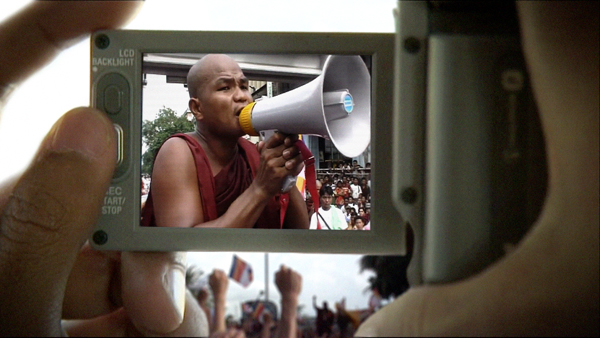|
Reviews of Recent Independent, Foreign, & Documentary Films in Theaters and DVD/Home Video

BURMA JV: REPORTING FROM A CLOSED
COUNTRY What happens in Myanmar stays in Myanmar. At least that’s the way the authorities would like it in this brutal, paranoid police state formerly known as Burma, a country where journalists are routinely imprisoned and sometimes shot. In September 2007, Myanmar’s state-enforced media blackout reached its darkest pitch when a coalition of students and Buddhist monks led a series of peaceful anti-government demonstrations. In response, the ruling junta shut off all Internet access and ordered a strict curfew in the capital city, Rangoon. Several people were killed, including a Japanese photographer who was murdered in front of thousands of protesters. Hiding among the droves at these demonstrations were journalists from the Democratic Voice of Burma. With Handicams concealed in their knapsacks, the reporter-activists braved untold perils to capture the events and smuggle their footage out of Burma. The Danish documentary Burma VJ appropriately glorifies their courage and serves as an attractive showcase for the DVB’s harrowing footage. The film centers around “Joshua,” the name director Anders Ostergaard gives to a scrappy DVB reporter who has a run-in with the police just weeks before the large-scale protests begin. Convinced someone’s following him, Joshua escapes to neighboring Thailand, where he becomes the group’s de facto editor, coordinating coverage via cell phone. As the events heat up, Ostergaard manages to construct some form of narrative, blending the DVB’s footage with recorded telephone conversations between Joshua and reporters inside Burma. There’s some cinematic drama here, although the incremental ratcheting up of events becomes a tad tedious at points, and the viewer wishes more time could be spent on context and less on an anguished game of phone tag between Joshua and his videographers. The footage, however, is remarkable. Searing scenes linger in the mind long after you’ve left the theater: a badly beaten monk’s cadaver floating like refuse in a canal; students huddling as the police approach (their rallying cry—“Those who are not afraid to die, come with us!”); and DVB activists sleeping on a damp floor, questioning whether all their efforts are in vain. “Our
stories are silent,” Joshua says at one point, and what he means is not
that the hidden camera footage is without sound but that the
videographer must remain quiet. He cannot ask questions, and there’s no
time for commentary. It’s good news, then, that these pictures loudly
speak for themselves. Stephen Heyman
|

